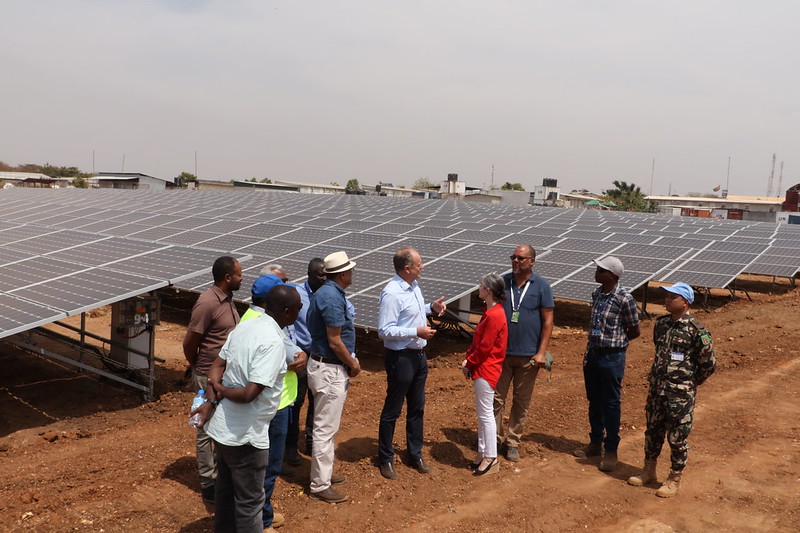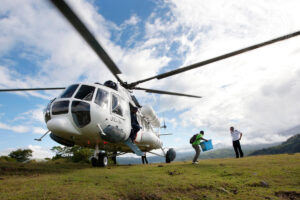Momentum is Building

The past year has witnessed a broad shift within the United Nations system and among Member States to adopt renewable energy in peace operations deployed in fragile settings, as part of a longer-term effort to better integrate climate solutions in conflict- and crisis-affected areas. Building on this momentum, 2022 presents an opportunity to consolidate these real gains and start to construct practical partnerships among the private and public sectors at the local, regional and global levels, to ensure the reality that installed renewable energy resources become a core operational capability for current and future UN peace operations.
The Powering Peace project has sought to drive access to renewable energy in fragile states by leveraging the presence of UN peace operations and aspirational UN Secretariat climate goals. Our work has shown that a system change around the role of energy in UN peace operations is necessary to facilitate a transition to renewables at scale. It has also demonstrated that while this system change is hard for a number of reasons, it is possible and the resulting rewards will pay environmental, economic, political, security and societal dividends for years to come.
The evident shift in approach to using renewable energy within the UN system during the course of 2021 has been accompanied by broad-based political support centered around the wider use of renewable energy in fragile states for the security, economic and environmental benefits it provides, and a sense of urgency among many Member States to acknowledge how climate change impacts conflicts and to better integrate those lessons learned into the UN’s work. This has been exemplified by the UN Security Council, which on numerous occasions has recognized the importance of this opportunity and the potential options, models and pathways to implementation for the UN and its partners. However, continued international momentum remains critical to success.
Notable Developments
Some of the notable larger-scale developments in 2021 that helped spotlight the evolution in international interest and support were:
- The Biden administration took office in January with firm commitments on climate change and a determination to play a leading global role. The new President’s early re-entry for the U.S. back into the Paris Climate accord and the appointment of former Secretary of State and Presidential candidate John Kerry to be the first climate change diplomatic envoy were tangible early steps. Speaking to the UN Security Council in February, Kerry said “It is time to start treating the climate crisis like the urgent security threat that it is.”1U.S. Department of State, “Secretary Kerry Participates in the UN Security Council Open Debate on Climate and Security,” 23 February 2021, https://www.state.gov/secretary-kerry-participates-in-the-un-security-council-open-debate-on-climate-and-security/.
- The Call to Action on Powering up Energy Investments in Fragile States in February 2021 led by the Council on State Fragility and the G7+ group of countries, that pledged to work together to make greater energy access in fragile contexts a reality and urged donors, international financial institutions and the private sector to prioritize operational capacity. It also highlighted the need to improve regulatory frameworks and assemble a better baseline of data.
- Taking its own climate goals seriously, the UN hosted in September the High-Level Dialogue on Energy, which brought together a range of governmental and nongovernmental stakeholders committed to achieving universal energy access and net-zero emissions. The result was a global strategy to achieve universal energy access and energy transition by 2030, including a set of concrete and practical milestones. This built on an agreed framework for cooperation towards accelerating the transition of United Nations field missions and host countries towards renewable energy and for the provision of technical assistance established between the UN and the International Renewable Energy Agency (IRENA), and spurred the establishment of over ten multi-stakeholder Energy Compacts. These compacts, which seek to establish energy technology pathways and investments aim to leverage more than $400 billion in new government and private-sector finance and investment, covering carbon-free energy, green hydrogen, integrated urban energy systems and gender and youth opportunities.
- November’s COP-26 in Glasgow focused on global commitments to combat climate change and mitigate environmental impact of human activity. A number of groups announced their intention to provide significant financial resources to back up those commitments and advance international investment.2Leslie Kaufman, Bloomberg Green, “Bezos, IKEA, and Rockefeller Promise Billions for Climate,” 1 November 2021, https://www.bloomberg.com/news/articles/2021-11-01/ikea-rockefeller-foundations-pledge-10-billion-for-climate. At a side panel in Glasgow, ‘Leading by Example: Greening Governments, UN and Other Public Sector Organizations,’ UN officials called for a transformative approach for the organization to fulfill its pledge of 80 percent renewably-sourced energy by 2030. Speakers also highlighted the UN’s example-setting role along the network opportunities to multiply the actions and successes of member states.
“The High-Level Dialogue on Energy and COP26 created opportunities for progress but promises must be translated into meaningful changes in people’s lives, … but we must go even further and faster to change the energy access gap.”
UN Secretary-General Guterres Remarks to the 12th Assembly of the International Renewable Energy Agency (IRENA), 18 January 2022
- The December UN Peacekeeping Ministerial in Seoul also spotlighted the important role energy generation and distribution can play in the success and durability of UN peacekeeping missions. To underscore that, several countries endorsed a smarter environmental footprint for peacekeeping missions and seven made concrete pledges to reduce the environmental footprint from peacekeeping deployments.
- The annual Assembly of the International Renewable Energy Agency (IRENA), meeting in January 2022 under the theme “Energy Transition: From Commitments to Action,” focused on the importance of “energy transition as an investment in our collective future.” The meeting brought together a range of vital stakeholders in the energy landscape and offered a unique opportunity to shape the energy discourse and drive investment in the growing green economy. A planned side-meeting focused on UN peace operations was deferred a few months to enable an in-person event.
Taken together these events and others reflect a growing international consensus and support for growing renewable energy capacity in highly challenging places and circumstances. The resulting dialogue has helped accelerate the necessary momentum to take this work forward. At the same time, many of the insights revealed through these conversations have helped to spotlight the remaining obstacles and challenges that must be addressed for widespread renewable deployment to occur.
Looking Ahead
Despite this progress, and in the face of ambitious UN climate goals, there is still a long way to go. UN peacekeeping is estimated to depend currently on renewable sources for just 4% of its energy usage, far from the Organizational goals of 40% by 2025 and 80% by 2030.3UN Department of Operational Support (DOS), “DOS Environment Strategy for Peace Operations – Executive Summary,” 2022, https://operationalsupport.un.org/sites/default/files/2022_environment_strategy_execsum_phase_two.pdf. A system change around energy provision is needed but has not yet begun in earnest. A growing recognition that climate trends affect conflicts and increased emphasis on modernizing UN missions while looking ahead to their transitions are also contributing factors to change. Yet, this shift is happening more slowly than is needed, and operational examples of a new UN approach are too few and far between. Renewable energy offers one of the most practical and impactful ways for the UN to link climate solutions with its peacebuilding mandates in fragile states. Looking ahead for 2022, it will be essential to build the concept into more of a roadmap, with a focus on learning from actual experience and identification of the needed practical steps to develop effective partnerships and establish the building blocks for progress. This will, among other objectives, advance the UN’s progress towards its own climate goals while also providing peacekeeping host nations a boost in reaching their climate targets. It will also start to demonstrate the proposition that a greater use of renewable energy can reduce some of the conflict vulnerability facing many UN peacekeeping missions dependent on trucked diesel fuel supplies, while contributing to future conflict mitigation through local energy supplies and resulting economic development.
Notes
- 1U.S. Department of State, “Secretary Kerry Participates in the UN Security Council Open Debate on Climate and Security,” 23 February 2021, https://www.state.gov/secretary-kerry-participates-in-the-un-security-council-open-debate-on-climate-and-security/.
- 2Leslie Kaufman, Bloomberg Green, “Bezos, IKEA, and Rockefeller Promise Billions for Climate,” 1 November 2021, https://www.bloomberg.com/news/articles/2021-11-01/ikea-rockefeller-foundations-pledge-10-billion-for-climate.
- 3UN Department of Operational Support (DOS), “DOS Environment Strategy for Peace Operations – Executive Summary,” 2022, https://operationalsupport.un.org/sites/default/files/2022_environment_strategy_execsum_phase_two.pdf.


